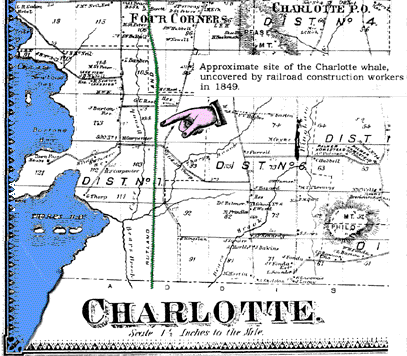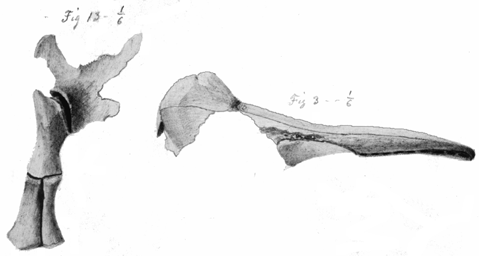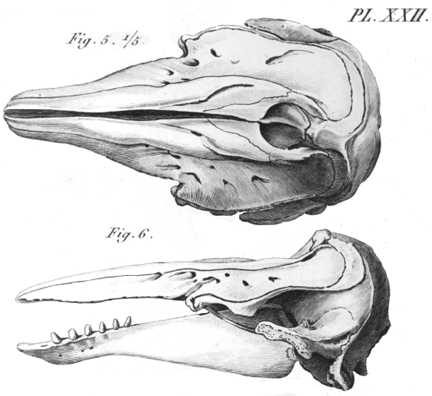 Zadock Thompson
Zadock Thompson Zadock Thompson
Zadock Thompson
 was widely respected in his day as a keen observer of natural history phenomena. Most of what is known about Thompson's original observations is based on published accounts from the 1850's. The following accounts are stated in his own words:
was widely respected in his day as a keen observer of natural history phenomena. Most of what is known about Thompson's original observations is based on published accounts from the 1850's. The following accounts are stated in his own words:
 "The fossil bones...were found on the line of the Rutland and Burlington Railroad in the month of August, 1849, in the township of Charlotte, about twelve miles south of Burlington, and a little more than a mile eastward from the shore of Lake Champlain....(While) widening a deep and extensive cut through stratified sand and clay, the workmen there struck upon a mass of bones. They were between eight and nine feet below the natural surface of the ground, and were very compactly bedded in fine adhesive blue clay.
"The fossil bones...were found on the line of the Rutland and Burlington Railroad in the month of August, 1849, in the township of Charlotte, about twelve miles south of Burlington, and a little more than a mile eastward from the shore of Lake Champlain....(While) widening a deep and extensive cut through stratified sand and clay, the workmen there struck upon a mass of bones. They were between eight and nine feet below the natural surface of the ground, and were very compactly bedded in fine adhesive blue clay.
 "(The railroad workers soon determined) that the bones discovered belonged to the anterior portion of the skeleton of some unknown animal, the head of which had already been broken into fragments by the workmen, and many of the fragments carried away with the earth which had been removed....Upon careful examination of these bones, I ascertained that the greater part of the head, all of the teeth, and several vertebrae, ribs and bones of the limbs, were wanting in order to complete the skeleton.
"(The railroad workers soon determined) that the bones discovered belonged to the anterior portion of the skeleton of some unknown animal, the head of which had already been broken into fragments by the workmen, and many of the fragments carried away with the earth which had been removed....Upon careful examination of these bones, I ascertained that the greater part of the head, all of the teeth, and several vertebrae, ribs and bones of the limbs, were wanting in order to complete the skeleton.
 "When I first looked at the bones, I was in doubt whether they belonged to an animal of the (whale or seal) families, but my doubt was soon removed by a careful examination of the caudal (tail) vertebrae. These I found to have their articulating surfaces convex and rounded in such a manner as to allow very little lateral motion. This circumstance plainly indicated that the movements of the animal in the water were effected by means of a horizontal caudal fin and therefore belonged to the (whale) family.
"When I first looked at the bones, I was in doubt whether they belonged to an animal of the (whale or seal) families, but my doubt was soon removed by a careful examination of the caudal (tail) vertebrae. These I found to have their articulating surfaces convex and rounded in such a manner as to allow very little lateral motion. This circumstance plainly indicated that the movements of the animal in the water were effected by means of a horizontal caudal fin and therefore belonged to the (whale) family.
 "My next objective was to ascertain, if possible, whether it was a living or an extinct species of (the whale) family. Being without specimens for comparison, my only reliance for aid was Cuvier's great work on fossil bones. By a comparison of the fossil whale with the descriptions and figures in that work, it was found to resemble the living rather than the extinct types, and that the (structure) of the head was very like that of the Beluga leucas, or small northern White Whale.
"My next objective was to ascertain, if possible, whether it was a living or an extinct species of (the whale) family. Being without specimens for comparison, my only reliance for aid was Cuvier's great work on fossil bones. By a comparison of the fossil whale with the descriptions and figures in that work, it was found to resemble the living rather than the extinct types, and that the (structure) of the head was very like that of the Beluga leucas, or small northern White Whale.
"The geologic formation in which (the bones) were found...consists of regularly stratified clay and sand, resting upon the Champlain rocks, or upon unstratified drift, and portions of it abound in marine bivalve fossil shells. These shells are of several species, nearly, or quite all of which are now found in a living state on the Atlantic shores of new England. The most abundant species is the Sanguinolaria fusca. The Mya arenaria, Saxocava rugosa and Mytilus edulis are also quite common.
"The depth of the cut for the railroad at the place where the skeleton was found is ten feet. About four feet of this depth, reckoning from the natural surface of the ground, consists of sand showing no signs of stratification. Below this is a mixture of sand and clay which is distinctly stratified for a depth of two and a half feet, below which is a vast (unstratified) bed of fine blue clay...which appears to have been, previous to the deposit of sand and clay above it, a kind of quagmire... I found in it indications of vegetable remains as to leave little doubt that this clay bed, once and for a long time, constituted a salt marsh, with rushes and grasses on the shore of the Pleistocene sea that then occupied the valley of Lake Champlain."
Click to learn how the fossil was found, or return to Directory of Exhibits or UVM Home Page.
__________________________________________________________________
Send questions, comments, changes, and additions to Wesley.Wright@uvm.edu and jefflhowe@verizon.net